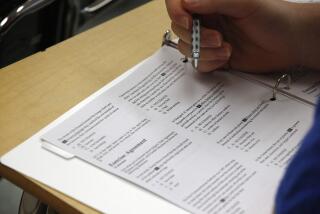Best of SATs, Worst of SATs
- Share via
Student essay tests can be a good thing or a bad thing. It’s a matter of judgment, we think. As the great novel “War and Peace” says about essay tests ....
Sorry. This kind of thing happens after imagining too many nervous high schoolers sweating through the SAT’s newest fear factor, the essay, which debuts next week.
The essay test is a decent, if flawed, instrument for measuring how well students write. At least it will pressure teachers to teach to the test, which in this case would be a good thing. Students need more instruction and practice in writing, as many schools have all but replaced written student reports with multiple-choice tests and other easier-to-grade projects.
We just hope colleges won’t take the essay scores too seriously.
The College Board, purveyor of the SAT and a host of other standardized tests, deserves credit for trying to make the essay scoring fair and meaningful. Students read a brief discussion on a question such as whether secrecy is a good thing. They then must write a persuasive essay, taking a position and backing it up with examples. The grading guidelines rightly put low emphasis on spelling and grammar errors -- which test-takers can’t check as they would in real life -- and look for organization, sentence flow, vocabulary choice and complexity of thought. Two readers grade every essay, and if their scores are off by more than a point on a scale of 1 to 6 points, the essay goes to a third supervising reader.
Despite good intentions, though, the scoring system tends to reward length over economy of thought, the gold-plated word over the simpler one and the global or academic example over the personal. Though it’s clear that an essay worth a 5 is superior to one worth a 2, scoring accuracy gets much fuzzier in the 4-to-6 range, even though that might result in a significant difference on the eventual SAT score.
The biggest problem is time. Students have 25 minutes to read and digest the topic, figure out how they feel, think up some good examples, organize their points and then write (by hand!). That fits the needs of a standardized testing schedule, but has little to do with real-life academic work.
The SAT has always had its uses and its inadequacies in predicting how students will fare in college. The redesigned test doesn’t change that. Still, it’s better to see students practicing the five-paragraph essay than mastering the SAT’s now-banished analogies (“Yacht is to regatta as mouse is to ... “). Thus, finally, and as stated earlier, SAT essay tests can be a good thing. Or a bad thing. It all depends. We think.
More to Read
Sign up for Essential California
The most important California stories and recommendations in your inbox every morning.
You may occasionally receive promotional content from the Los Angeles Times.














